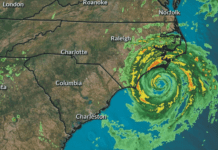
During our man-overboard light testing, we also looked into the effectiveness of using a waterproof flashlight as a man-overboard signal. Most offshore sailors already carry a compact flashlight or wear a headlamp during night watches-why not choose one that can do double-duty? A dual-purpose flashlight would be in some ways similar to a cellphone-a device designed primarily for everyday use, but also capable of serving a lifesaving role in the event of an emergency.
After completing our on-the-water testing of dedicated man-overboard (MOB) lights, we gathered several flashlights from our ongoing long-term flashlight test and a variety of other battery-powered lights and put them through the same on-the-water test as the MOB lights (see How We Tested).
The first test product was an old but well-made mini-Maglite with a red lens. Testers on the water pointed it toward the observers location on shore (.62 nautical miles away). The light drew their attention about as well as the Fulton 102 man-overboard light, which we also used as a baseline in our MOB light comparison. An inexpensive Garrity flashlight also matched the Fulton 102. A Petzel headlamp appeared much brighter than the Fulton, particularly in its strobe mode. Finally, we fired up a Q-beam spotlight, and it trumped the headlamp and the flashlights.
It is important to note that all of these devices are spot beams. To be noticed, the person in the water must shine them in the direction of potential rescuers. Proper MOB lights are generally visible from 360 degrees without any manipulation.
Out of curiosity, we rigged up a Coast Guard-approved sailboat running light (a masthead/anchor lamp combo) made by Signal Mate. The shore observers were impressed, calling it the brightest and most noticeable light yet to be displayed. Its interesting to note that the Signal Mate has merely a 2-nautical-mile Coast Guard visibility rating. Many of the MOB lights we tested had much more impressive manufacturers ratings, but none came close to matching the Signal Mates visibility.
Bottom line: In the search for a super-bright flashlight/MOB light, the advertised brightness can be misleading-and meter readings are just part of the story. A flashlight with seemingly stellar specs can be almost invisible on the water, lost against background glare and the clutter of shore lights.
Some of the most promising flashlight/MOB lights were newer LED tactical flashlights with strobe features. A flashlight like the Power Tac E5 fits in the palm of your hand and delivers a scalding 950-lumen strobe that can stand out against background clutter, but lasts only three hours. At a lower setting, it delivers continuous light at an 82-lumen rating for 15 hours. The unit runs on two CR 123A batteries or one 18650 rechargeable Li-ion battery and sells for $75.
While these strobe-enabled tactical lights were impressive, we have two major concerns about using them as MOB signals. The first is the waterproof rating. Some are advertised as being water resistant, but do not claim a specified rating. Others, like the Mini Maglite are rated only IPX4, splash proof. Any light to be used near the water should have water-resistance rating of IPX7 or higher, which means they can be submerged in 1 meter of water for 30 minutes.
None of the flashlights we examined met two of our chief MOB signal criteria: durability and battery life. Flashlights have very high failure rates, and if the light is to be used on a daily basis, the chance of failure increases. In addition, the state of charge on a flashlight used daily is usually unknown, and could possibly be quite low. Could we-or should we-rely on it in an emergency?
It seems obvious that a bright, pocket-sized flashlight can be a useful secondary or backup emergency signaling device. In our view, however, they are not replacements for dedicated, personal MOB lights. Once we find enough of these dual-purpose flashlights/signals, well do a proper test. If you have contenders to recommend, let us know at practicalsailor@belvoir.com.





































